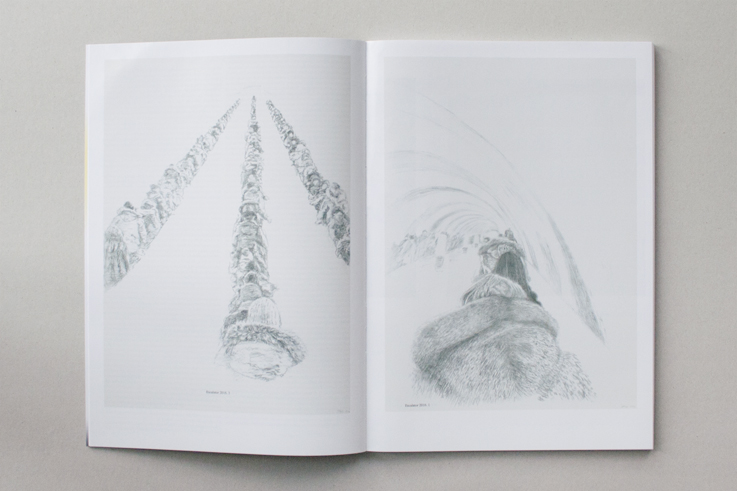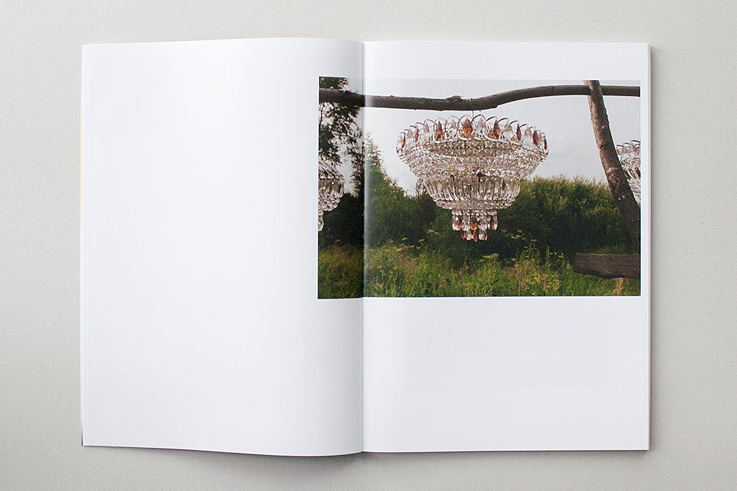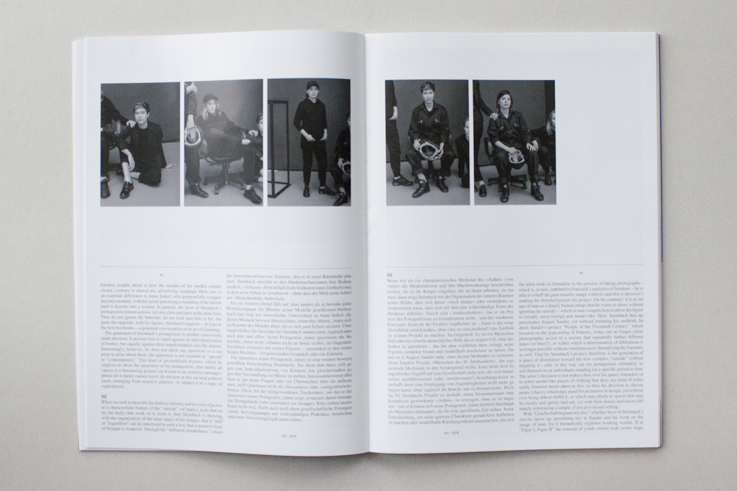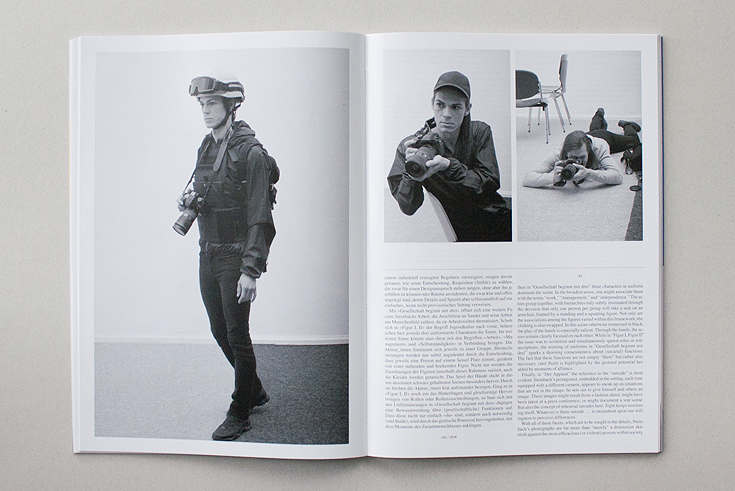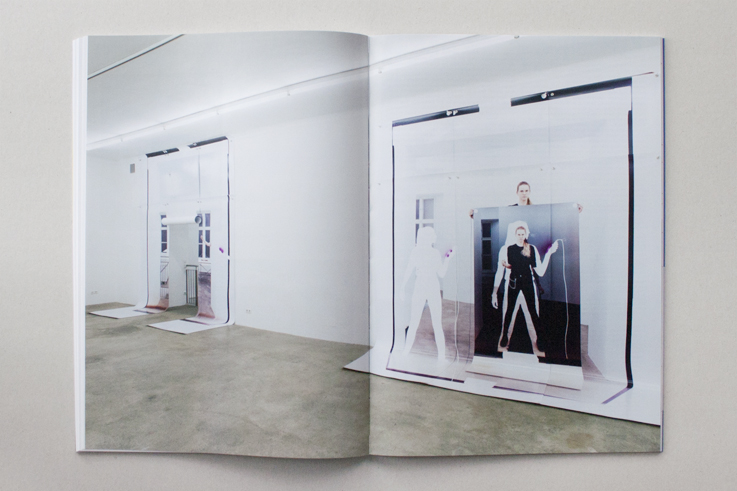Camera Austria International
142 | 2018
- ADAM SZYMCZYK
Olga Chernysheva: Sheer Presence - OLGA CHERNYSHEVA
- MATTHEW RANA
“Memory”: The Expanded Cinema of Bernadette Mayer - BERNADETTE MAYER
- MAREN LÜBBKE-TIDOW
Andrzej Steinbach: Dissonances - ANDRZEJ STEINBACH
- ORIT GAT
Sophie Thun: The Body and the Image - SOPHIE THUN
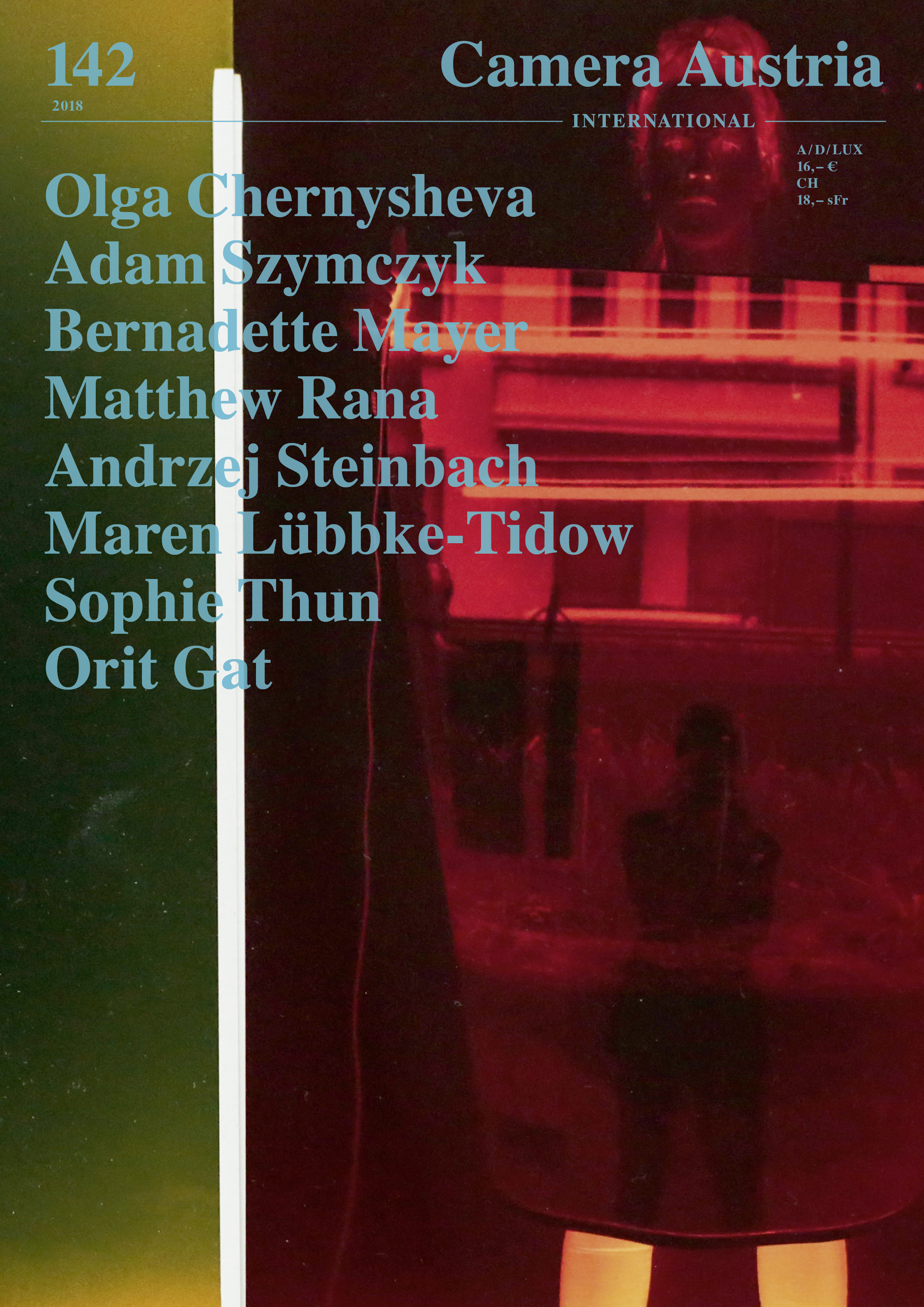
Preface
Pictures of people and situations believed to be typical of everyday life are what the artists featured in this issue of Camera Austria International have made the focus of their photographic work. They all share an interest in what Henri Lefebvre described, in his Critique of Everyday Life, as “lived experience”—in the conviction that this is anything other than banal or trivial.
Read more →Camera Austria International 142 | 2018
Preface
Pictures of people and situations believed to be typical of everyday life are what the artists featured in this issue of Camera Austria International have made the focus of their photographic work. They all share an interest in what Henri Lefebvre described, in his Critique of Everyday Life, as “lived experience”—in the conviction that this is anything other than banal or trivial.
The photographs, videos, drawings, and paintings of Olga Chernysheva deal with everyday life in post-communist Russia, which the artist views with equal measures of precision and empathy. As Adam Szymczyk writes, this view is free of “Ostalgia” and eludes the kind of orientalization so frequently experienced by East European artists. Instead, he sees Chernysheva’s artistic work in the tradition of the (ir)realistic authors of the 1920s and 1930s, who tried to capture the quotidian in the Russia of the post-revolutionary era in all its absurdity. “It is the quality of sheer presence, of being, that interests the artist,” notes Szymczyk. “People gazing, standing in line, loitering, walking, parading, dancing, guarding.”
A similarly calm yet meticulous view of everyday life is taken by the photographic narrative project “Memory,” developed by the American author Bernadette Mayer in 1971—her only visual work to date. For “Memory,” Mayer shot an entire roll of 35mm Kodachrome slide film on each day of July in the year 1971, while also recording her daily activities in a journal and on audiotape. Matthew Rana illustrates the affinities between “Memory” and the expanded cinema of the 1960s and 1970s, situating Mayer’s visual and literary surveys in the age of cybernetics and the related oscillation between order and chaos.
Taking the works “Figur I, Figur II” (2015), “Gesellschaft beginnt mit drei” (2017), and “Der Apparat” (2018) as examples, Maren Lübbke-Tidow traces the “spaces of dissonance” arising in the work of Andrzej Steinbach. His performative series of portraits, developed within a precisely planned dramaturgy, reveals how social practice and cultural ascriptions influence the image of the self. Yet the clear interpretability of these portraits is repeatedly disrupted, for “the figure slips away and keeps coming back,” as Lübbke-Tidow quotes Anne Imhof. For the author, “it is an image of man or a deeply human image that Steinbach wants to show, without ignoring the outside—which in turn compels him to allow his figures to initially seem foreign and model-like.”
Another type of portrait is explored by Sophie Thun, who superimposes architectural spaces with photograms of self-portraits. By situating these superimpositions in an exhibition space, she often inscribes herself therein in almost illusory form. Orit Gat creates references to art-historical contexts and maps out how Sophie Thun’s photographs tie into a long tradition of female artists’ self-representation, going back to the mid-sixteenth century, but also how body and space become intertwined in the artist’s works. In Gat’s view, Thun’s photographs “start with the artist’s body and the relationship she delineates between it and the space.”
We are pleased that Adam Broomberg and Oliver Chanarin agreed to take over the Forum section of this issue. Together with students from their class at the Hochschule für bildende Künste in Hamburg, they have focused on those images that they “still care about” against the backdrop of the endless stream of pictures on the Internet. Inspired by the Surrealist method of “Cadavre exquis,” a captivating sequence of images and an introductory text were created that open up unexpected relationships between their individual parts.
Christina Töpfer and the Camera Austria Team
June 2018
Cover: Sophie Thun, Double release (Nonnenwerthstraße to Grangasse), 2017. Analogue color photographs, 25.4 × 20.3 cm each. Courtesy: the artist and Mélange, Cologne.
Entries
Forum
Presented by Adam Broomberg and Oliver Chanarin: Students from the photo class of Hochschule für bildende Künste Hamburg (HFBK)
Adam Broomberg, Agnieszka Mastalerz, Alexander Kadow, Anna Justke, Anna Larsen, Conrad Hübbe, Elina Saalfeld, Elisa Goldammer, Florian Bräunlich, Franziska Koenig, Georg Kußmann, Janosch Boerckel, Jenny Mehren, Jonas Hensel, Julian Slagman, Kristina Savutsina, Luisa Telles, Maik Graef, Manda Steinhauser, Marinus Reuter, Max Eicke, Max Schwarzmann, Morina Krohn, Naama Salzberg, Nina Bühlmann, Oliver Chanarin, Reto Buser, Rhea Reiblein, Seda Yildiz, Stephan Vavra, Svenja Wassill, Thora Schmid.
Exhibitions
Widerständige Praktiken im digitalen Mainstream
Virtual Normality: Netzkünstlerinnen 2.0
Museum der bildenden Künste Leipzig
Pics or It Didn’t Happen: Images Banned from Instagram
Prestel Verlag, Munich London / New York 2017
SUSANNE HOLSCHBACH
Being: New Photography 2018
Museum of Modern Art, New York
LARA ATALLAH
Sondra Perry: Typhoon coming on
Serpentine Sackler Gallery, London
REBECCA WILTON
Family Pictures
Columbus Museum of Art (CMA), Columbus
GINA OSTERLOH
Ana Hoffner & Kay Walkowiak:
The Bacha Posh Project & Given. The Haunting Ghost
5020, Salzburg
MARGIT NEUHOLD
Dirk Braeckman
BOZAR, Brussels
M – Museum Leuven
STEVEN HUMBLET
Clare Strand: The Discrete Channel with Noise
Centre photographique d’Île-de-France, Paris
MICHÈLE COHEN HADRIA
Tony Chakar: As in a Beginning
Van Abbemuseum, Eindhoven
ARNISA ZEQO
Lizzie Fitch / Ryan Trecartin: Premise Place (edit 1)
Kunsthalle Krems
CHRISTIAN EGGER
Günter Peter Straschek: Emigration – Film – Politik
Museum Ludwig, Cologne
MORITZ SCHEPER
responseABILITY
< rotor > center for contemporary art, Graz
Kunsthalle Exnergasse, Wien
WALTER SEIDL
Korpys/Löffler: Personen, Institutionen, Objekte, Sachen
Kunsthalle Tübingen
Kunstverein Braunschweig
Hartware MedienKunstVerein, Dortmund
SABINE WEIER
Heidi Specker: FOTOGRAFIN
Kunstmuseum Bonn
ROLF SACHSSE
Arne Schmitt: Basalt. Ursprung Gebrauch Überhöhung
Bielefelder Kunstverein, Bielefeld
LISA LONG
Luigi Ghirri: Karte und Gebiet
Museum Folkwang, Essen
Museo Reina Sofia, Madrid
Jeu de Paume, Paris
RADEK KROLCZYK
Books
Wahlkampf und Medien
Ferdinand Kriwet: Campaign. Wahlkampf in den USA
Droste Verlag, Düsseldorf 1974
Jonathan Horowitz: Your Land / My Land. Election ’12
Gavin Browns Enterprise, New York 2014
Ludovic Balland: American Readers at Home
Scheidegger & Spiess, Zurich 2017
JAN WENZEL
Rineke Dijkstra: The Louisiana Book
Koenig Books, London 2017
Rineke Dijkstra: WO MEN
Verlag der Buchhandlung Walther König, Cologne 2017
Figuren: Rineke Dijkstra und die Sammlung des Sprengel Museum Hannover
Sprengel Museum Hanover 2018
CAROLIN FÖRSTER
The Pigeon Photographer, ed. Nicolò Degiorgis and Audrey Solomon
Bolzano 2017
CHRISTINA TÖPFER
Mareike Stoll: ABC der Photographie. Photobücher der Weimarer Republik als Schulen des Sehens
Verlag der Buchhandlung Walther König, Cologne 2018
GISLIND NABAKOWSKI
Manfred Willmann: Blitz & Enzianblau
Fotohof edition, Salzburg 2017
JENS ASTHOFF
Nico Joana Weber: Monstera Deliciosa
Grass Publishers, 2018
TACO HIDDE BAKKER
Imprint
Publisher: Reinhard Braun
Owner: Verein CAMERA AUSTRIA. Labor für Fotografie und Theorie.
Lendkai 1, 8020 Graz, Österreich
Editor-in-Chief: Christina Töpfer.
Editor: Margit Neuhold.
Translations: Dawn Michelle d’Atri, Nicholas Huckle, Amy Klement, Wilfried Prantner, Sabine Weier.
English Proofreading: Dawn Michelle d’Atri.
Acknowledgments: Janosch Boerckel, Florian Bräunlich, Adam Broomberg, Nina Bühlmann, Reto Buser, Oliver Chanarin, Olga Chernysheva, Matthew Connors, Max Eicke, Carolin Förster, Orit Gat, Elisa Goldammer, Philip Good, Maik Graef, Jonas Hensel, Herwig G. Höller, Conrad Hübbe, Anna Justke, Alexander Kadow, Franziska Koenig, Morina Krohn, Claudia Kudinova, Georg Kußmann, Anna Larsen, Maren Lübbke-Tidow, Agnieszka Mastalerz, Bernadette Mayer, Jenny Mehren, Matthew Peters, Matthew Rana, Rhea Reiblein, Marinus Reuter, Elina Saalfeld, Naama Salzberg, Kristina Savutsina, Thora Schmid, Max Schwarzmann, Julian Slagman, Helen Smedberg, Andrzej Steinbach, Manda Steinhauser, Adam Szymczyk, Luisa Telles, Sophie Tappeiner, Sophie Thun, Stephan Vavra, Svenja Wassill, Seda Yildiz.
Copyright © 2018
No parts of this magazine may be reproduced without publisher’s permission.
Camera Austria International does not assume any responsibility for submitted texts and original materials.
ISBN 978-3-902911-44-5
ISSN 1015 1915
GTIN 4 19 23106 1600 5 00142

